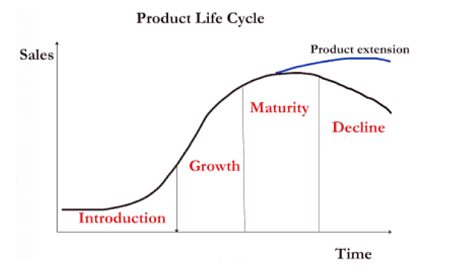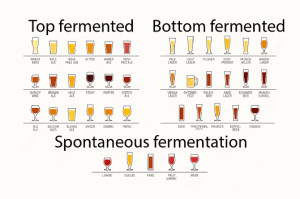Product life cycle-
The product life cycle is a business concept that describes the stages a product goes through from its introduction to the market to its eventual decline and withdrawal. It typically includes the following stages:
- Introduction: This is the launch phase where the product is introduced to the market. Marketing efforts are high to build awareness and interest. Sales growth is slow as the market is not yet aware of the product. Profits are usually negative or low due to high costs of development and promotion.
- Growth: During this phase, the product gains acceptance, and sales increase rapidly. Profits start to rise as economies of scale are achieved, and marketing costs per unit decrease. Competitors may start to enter the market.
- Maturity: In the maturity phase, sales growth slows as the product reaches widespread acceptance. The market becomes saturated, and competition is intense. Companies focus on differentiating their product and finding new market segments. Profits may start to decline due to price competition.
- Decline: This final stage sees a decline in sales and profits as the product loses consumer interest and is outpaced by new innovations or changing consumer preferences. Companies must decide whether to rejuvenate the product, harvest it by reducing costs, or discontinue it.
Key Characteristics at Each Stage
- Introduction:
- High marketing and promotional costs.
- Low or negative profits.
- Limited distribution.
- Focus on educating potential customers.
- Growth:
- Rapid sales increase.
- Increasing profits.
- Expansion in distribution channels.
- Increased competition.
- Marketing focuses on differentiating the product.
- Maturity:
- Sales peak and growth slows.
- High but stable profits.
- Intense competition leads to price reductions.
- Emphasis on product differentiation and feature enhancement.
- Saturation of the market.
- Decline:
- Declining sales and profits.
- Reduction in marketing expenses.
- Potential discontinuation of the product.
- Companies may attempt to innovate or pivot to new products.
Strategies for Each Stage
- Introduction:
- Invest in advertising and promotions.
- Build distribution channels.
- Focus on creating product awareness and trial.
- Growth:
- Improve product quality and add new features.
- Expand distribution to reach a wider audience.
- Competitive pricing strategies.
- Maturity:
- Modify the market by finding new customer segments.
- Innovate and improve the product.
- Focus on customer loyalty and retention.
- Decline:
- Cut costs and find ways to maintain profitability.
- Consider discontinuing the product.
- Explore opportunities for product reinvention or repositioning.
Understanding the product life cycle helps businesses make strategic decisions about marketing, production, and financial planning to maximize the product’s profitability over its lifespan.
What is Required Product life cycle
The Required Product Life Cycle (RPLC) is a concept that extends the traditional product life cycle (PLC) framework by emphasizing the importance of aligning product development with specific market needs and customer requirements. Unlike the standard PLC, which focuses on the stages a product naturally progresses through, the RPLC integrates market demand and customer expectations into each phase of the product’s life cycle.
Key Features of the Required Product Life Cycle (RPLC):
- Market Demand Focus: Throughout the RPLC, the emphasis is on identifying and responding to market demand. This involves conducting thorough market research to understand customer needs, preferences, and pain points.
- Customer Requirements: At every stage—from product conceptualization to launch and throughout its life—customer requirements drive decision-making. This ensures that the product meets or exceeds customer expectations, enhancing its market acceptance and longevity.
- Flexibility and Adaptability: Unlike a rigid sequence of stages, the RPLC framework allows for flexibility and adaptability. It encourages continuous feedback loops with customers and stakeholders, enabling adjustments to the product’s development and marketing strategies as needed.
- Iterative Development: Product development under the RPLC model is often iterative, with frequent iterations based on customer feedback and market response. This iterative approach helps in refining the product features, improving its value proposition, and sustaining its relevance in the market.
- Lifecycle Extension: The goal of the RPLC is often to extend the product’s lifecycle by maintaining its alignment with evolving market needs and technological advancements. This can involve periodic updates, upgrades, or diversification of the product to cater to changing customer demands.
Implementation Strategies:
- Market Research: Conduct comprehensive market research to understand customer needs, preferences, and trends.
- Customer Engagement: Engage with customers throughout the product lifecycle to gather feedback and insights.
- Agile Development: Adopt agile development methodologies to facilitate iterative improvements and quick responses to market changes.
- Continuous Improvement: Continuously monitor and evaluate the product’s performance in the market, and make necessary adjustments to enhance its competitiveness.
- Lifecycle Management: Develop strategies for each stage of the RPLC—from introduction to decline—to optimize the product’s performance and profitability.
By focusing on market demand and customer requirements, the Required Product Life Cycle aims to enhance the product’s success and sustainability in the marketplace. It encourages businesses to be proactive in anticipating and fulfilling customer needs, thereby increasing their competitiveness and long-term profitability.
Who is Required Product life cycle
The Product Life Cycle (PLC) refers to a well-established concept in marketing and product management that describes the stages a product goes through over its lifespan in the market. It is not a person but rather a framework or model used by businesses to understand and manage the trajectory of a product from its introduction to its decline and potential discontinuation.
Stages of the Product Life Cycle:
- Introduction: This is the initial stage where a new product is launched into the market. Sales are typically low as awareness is built and customers are introduced to the product. Companies often invest heavily in promotion and distribution during this phase.
- Growth: In this stage, the product gains acceptance and sales start to increase rapidly. Customers become more aware of the product’s benefits, and positive word-of-mouth may contribute to its growth. Profits usually improve as sales volumes increase and production costs decrease.
- Maturity: The maturity stage is characterized by stable sales and market saturation. Competitors may have entered the market, leading to increased competition and price pressures. Companies focus on differentiating their product through branding, new features, or enhancements to maintain market share.
- Decline: In the decline stage, sales begin to decrease as the market becomes saturated or consumer preferences shift towards newer products or technologies. Companies may decide to discontinue the product, reduce marketing efforts, or find ways to extend its life cycle through revitalization strategies.
Importance of Product Life Cycle:
Understanding the product life cycle helps businesses make informed decisions about marketing strategies, pricing, product development, and resource allocation. It provides a framework for anticipating market changes, identifying opportunities for growth, and managing the profitability of products over time.
In essence, the Product Life Cycle is a fundamental concept in marketing and business strategy that guides how companies navigate the stages of a product’s existence in the marketplace.
When is Required Product life cycle
The term “Required Product Life Cycle” (RPLC) doesn’t have a widely recognized or standardized meaning in business or academic literature as of my last update in January 2022. It’s possible that it could refer to a specific concept or framework used within a particular industry, organization, or academic context that has emerged after my knowledge cutoff.
If “Required Product Life Cycle” is being used in a specific context that you are familiar with or referring to a particular concept in your field, it would be helpful to provide more details or context. This would allow for a more accurate explanation or discussion about what the term entails and when it applies.
Where is Required Product life cycle

It seems there might be confusion or a misunderstanding regarding the term “Required Product Life Cycle” (RPLC). Based on the typical understanding of product life cycles in business and management, “Required Product Life Cycle” does not refer to a specific location or physical entity. Instead, it likely describes a concept, framework, or approach used within a particular context such as:
- Business and Marketing Strategy: RPLC could be a strategic approach used by businesses to align product development closely with customer needs and market demands throughout the product’s life cycle.
- Product Development: In product management and development, RPLC might refer to methodologies or frameworks that emphasize iterative improvements and adaptations based on required customer specifications or market demands.
- Academic or Research Context: RPLC could also be a term used in academic or research literature to describe a specific theoretical framework or model related to product life cycles.
If “Required Product Life Cycle” is being used in a specific context that you are aware of, such as within a company, industry, or academic discipline, it would be beneficial to provide more details or context. This would help in understanding how the term is defined and applied in that particular setting.
How is Required Product life cycle
Based on the information available and typical interpretations in business and marketing contexts, the term “Required Product Life Cycle” (RPLC) doesn’t have a universally recognized definition or framework. However, we can speculate on how such a concept might be conceptualized or applied based on general principles of product lifecycle management and customer-centric strategies:
Speculative Concept of Required Product Life Cycle (RPLC):
- Customer Needs Focus: The RPLC could emphasize identifying and fulfilling specific customer requirements throughout the product’s lifecycle. This would involve comprehensive market research to understand customer preferences, pain points, and evolving needs.
- Iterative Development: Unlike traditional product life cycles that follow a linear progression (introduction, growth, maturity, decline), the RPLC might involve iterative development cycles. This would allow for continuous adjustments and improvements based on ongoing customer feedback and market dynamics.
- Agile and Responsive Strategy: Businesses applying the RPLC concept would likely adopt agile methodologies in product development. This approach facilitates quick iterations and adaptations to ensure that the product meets required specifications and maintains relevance in the marketplace.
- Lifecycle Management: RPLC would encompass strategies for each stage of the product’s life, from initial concept development through to eventual decline or product retirement. This holistic approach would ensure that the product remains aligned with customer expectations and market demands at all times.
- Customization and Flexibility: Products managed under the RPLC framework might be more customizable or flexible to accommodate varying customer needs and preferences. This could involve offering different product versions, configurations, or enhancements tailored to specific customer segments.
Implementation Considerations:
- Market Research and Customer Insights: Conducting thorough market research and gathering customer insights are foundational to implementing an RPLC strategy. This ensures that product development efforts are focused on meeting essential or required customer specifications.
- Continuous Feedback Loops: Establishing mechanisms for ongoing customer feedback and engagement helps in refining the product over time. This iterative approach ensures that the product remains competitive and valuable in the market.
- Adaptive Development Processes: Adopting agile development practices allows for rapid adjustments and improvements based on changing customer requirements and market conditions. This agility is crucial for maintaining product relevance and competitiveness.
- Strategic Product Management: Developing clear strategies for each stage of the RPLC, including introduction, growth, maturity, and decline, helps in optimizing the product’s performance and maximizing its lifecycle value.
In essence, while the specific details of an RPLC framework may vary depending on its application context, the core idea revolves around aligning product development closely with required customer specifications and market demands throughout the product’s lifecycle. This customer-centric approach aims to enhance product success and sustainability in the marketplace.
Case Study on Product life cycle
Introduction Stage
Overview: A leading technology company launches a new flagship smartphone model in a highly competitive market.
Objectives:
- Build awareness and generate excitement about the new product.
- Establish a presence in the market and gain early adopters.
- Position the product as innovative and technologically advanced.
Strategies:
- Extensive marketing campaigns across various channels (digital, print, social media).
- Distribution partnerships with major retailers and carriers to ensure wide availability.
- Limited-time promotional offers and incentives to encourage early adoption.
Challenges:
- High initial costs due to product development and marketing expenditures.
- Limited consumer awareness and potential skepticism about new features.
Growth Stage
Overview: The smartphone gains traction in the market, and sales begin to increase rapidly.
Objectives:
- Capture a larger market share and increase sales volume.
- Enhance product features and address initial customer feedback.
- Maximize profitability through economies of scale in production.
Strategies:
- Continuous product improvements based on user feedback and technological advancements.
- Expansion of distribution channels to reach a broader audience.
- Pricing strategies to maintain competitiveness while maximizing profitability.
Challenges:
- Intensifying competition from rival smartphone manufacturers.
- Balancing production scalability with maintaining product quality and brand reputation.
Maturity Stage
Overview: The smartphone reaches a phase of stable sales growth, but competition intensifies.
Objectives:
- Sustain market leadership and defend market share.
- Differentiate the product through brand loyalty and enhanced features.
- Optimize costs while maintaining product quality.
Strategies:
- Product diversification (e.g., different models for different market segments).
- Focus on customer retention through loyalty programs and customer support.
- Marketing campaigns emphasizing product reliability, longevity, and ecosystem integration.
Challenges:
- Saturation of the smartphone market leading to price pressure and margin erosion.
- Need for continuous innovation to prevent product obsolescence.
Decline Stage
Overview: Sales of the smartphone start to decline due to market saturation and shifting consumer preferences.
Objectives:
- Manage product decline while maximizing profitability.
- Explore options for extending the product’s life cycle or phasing it out gracefully.
- Plan for the launch of successor products or innovations.
Strategies:
- Cost reduction measures in production and marketing expenses.
- Clearance sales and promotional discounts to sell remaining inventory.
- Consideration of product rejuvenation (e.g., software updates, new features) to prolong viability.
Challenges:
- Maintaining brand equity and customer loyalty during product decline.
- Managing inventory and supply chain logistics effectively.
Conclusion
In this hypothetical case study, we’ve outlined the product life cycle stages of a smartphone, from introduction to decline. Each stage involves specific objectives, strategies, and challenges that companies must navigate to maximize the product’s success and profitability in the market. Understanding and effectively managing the product life cycle is crucial for businesses to make informed decisions about resource allocation, marketing strategies, and product development efforts.
White paper on Product life cycle
Writing a white paper on the product life cycle (PLC) can be an insightful way to explore and explain this fundamental concept in business and marketing. Here’s an outline and key points you could include in a white paper on the product life cycle:
Title: Understanding the Product Life Cycle: Strategies for Success
Abstract
Provide a brief overview of what the white paper will cover, emphasizing the importance of understanding the product life cycle in today’s competitive business environment.
Introduction
- Define the Product Life Cycle (PLC) and its significance in product management and marketing.
- Introduce the main stages of the PLC: Introduction, Growth, Maturity, and Decline.
The Product Life Cycle Stages
1. Introduction Stage
- Objective: Introduce the product to the market and build awareness.
- Strategies: Heavy marketing and promotional campaigns, selective distribution.
- Challenges: High costs, potential market skepticism.
2. Growth Stage
- Objective: Maximize market share and profitability.
- Strategies: Expand distribution, improve product features, aggressive pricing.
- Challenges: Increased competition, maintaining quality and scalability.
3. Maturity Stage
- Objective: Maintain market position and extend product life.
- Strategies: Product diversification, focus on customer loyalty and retention.
- Challenges: Market saturation, price pressure, innovation fatigue.
4. Decline Stage
- Objective: Manage decline and maximize profitability.
- Strategies: Cost reduction, clearance sales, product rejuvenation.
- Challenges: Declining sales, managing brand reputation, inventory management.
Implications for Business Strategy
- Discuss how understanding the PLC helps businesses make informed decisions at each stage.
- Explain the importance of adapting strategies based on the product’s position in the PLC.
- Highlight case studies or examples of successful and unsuccessful PLC management.
Conclusion
- Summarize key takeaways about managing the product life cycle effectively.
- Discuss future trends or considerations in product life cycle management.
References
- Provide a list of sources and references used to support the information and insights presented in the white paper.
Additional Tips:
- Visuals: Incorporate graphs, charts, or diagrams to illustrate the PLC stages and key concepts.
- Case Studies: Include real-world examples or case studies to demonstrate how different companies have managed their product life cycles.
- Audience Consideration: Tailor the language and depth of explanation based on the target audience’s familiarity with business concepts.
Writing a white paper on the product life cycle allows you to delve deep into a critical aspect of business strategy and provide valuable insights for businesses looking to optimize their product management practices.
Industrial Application of Product life cycle
The industrial application of the Product Life Cycle (PLC) concept is crucial for manufacturing and industrial sectors to manage their products effectively from inception to eventual retirement. Here’s how the PLC concept applies specifically to industrial applications:
1. New Product Development (Introduction Stage)
In industrial settings, new product development is often a lengthy and resource-intensive process. Companies invest in research and development (R&D) to innovate and create products that meet specific industry needs or solve existing challenges. During the introduction stage:
- Market Research: Industrial firms conduct extensive market research and feasibility studies to ensure there is demand for the new product.
- Prototype Testing: Prototypes undergo rigorous testing to meet quality standards and regulatory requirements.
- Launch Strategies: Companies plan targeted marketing campaigns and distribution channels to introduce the product to industrial buyers and decision-makers.
2. Ramp-Up and Growth Stage
Once a new industrial product gains market acceptance, it enters the growth stage where production and sales increase rapidly:
- Scaling Production: Manufacturers ramp up production to meet growing demand while optimizing manufacturing processes to improve efficiency and reduce costs.
- Market Penetration: Companies expand their market reach by establishing partnerships, distribution networks, and strategic alliances.
- Continuous Improvement: Feedback from customers and production data drive continuous product improvements and iterations to enhance performance and reliability.
3. Maturity Stage
In the industrial context, the maturity stage represents a period of stability and market saturation for the product:
- Competition and Differentiation: Companies focus on product differentiation through advanced features, customization options, and enhanced service offerings.
- Lifecycle Management: Strategic decisions are made regarding pricing, distribution, and customer support to maximize profitability and sustain market share.
- Long-Term Planning: Organizations plan for the product’s lifecycle extension through upgrades, updates, and aftermarket services.
4. Decline and Obsolescence
As industrial products age, they enter the decline stage due to technological advancements, changing regulations, or shifts in market preferences:
- Phasing Out: Manufacturers may phase out older products and components to make way for newer technologies.
- Legacy Support: Companies provide support services such as spare parts, repairs, and maintenance for legacy products still in use by customers.
- Transition Strategies: Organizations manage the transition to newer products or technologies by offering incentives for upgrades and ensuring a smooth transition for customers.
Benefits of Applying PLC in Industrial Applications:
- Strategic Planning: PLC helps industrial firms develop long-term strategies for product development, marketing, and resource allocation.
- Risk Management: By anticipating market changes and customer needs, companies can mitigate risks associated with product lifecycle transitions.
- Resource Optimization: Efficient use of resources in R&D, production, and marketing throughout the product’s lifecycle improves profitability and sustainability.
- Customer Satisfaction: Meeting industrial buyers’ evolving needs through lifecycle management enhances customer satisfaction and loyalty.
In summary, the industrial application of the Product Life Cycle concept is instrumental in guiding strategic decisions, optimizing resource allocation, and ensuring sustainable growth in manufacturing and industrial sectors. By understanding and effectively managing each stage of the PLC, companies can maintain competitiveness, innovate continuously, and meet the demands of industrial markets effectively.





